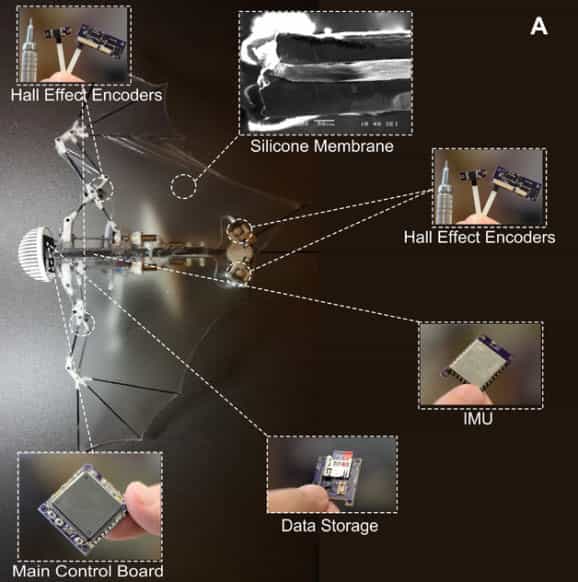Bat Bot – Researchers Unveil An Autonomous Robot That Copy A Bat’s Flight
Researchers at California Institute of Technology and the University of Illinois at Urbana-Champaign have created a robot that copies a bat flight – The Bat Bot Robot. It’s not the first to imitate bat biology in pursuit of aerodynamic, but a number of new techniques put it at the head of the pack, or rather a colony. Bat Bot robot is a remix on an ornithopter, a machine that uses flapping wings to take flight as opposed a propeller or a balloon.
Bats have 40 joints in their wings, allowing for an extraordinary amount of control over everything from angle to the wing membrane’s rigidity. “Arguably, bats have the most sophisticated powered flight mechanism among animals,” Soon-Jo Chung, a professor of aerospace at the California Institute of Technology. However, attempting to replicate this complexity is doomed to failure, as even the best joints and actuators we have are nowhere near as powerful or lightweight as bats’ natural ones.
“This school of thought can lead to the design and development of robots with many degrees of actuation that simply cannot fly,” Soon-Jo Chung continues. On the other hand, eliminate too many of the joints and the resulting flight style is nothing like the fluid, elegant motion of the bat.

Built from carbon fiber bones and 3D-printed socket joints, Bat Bot robot weighs just 93 grams and the silicon-based wing membrane is only 56 microns thick with a roughly one-foot wingspan. “Our work demonstrates one of the most advanced designs to the date of a self-contained flapping-winged aerial robot with bat morphology that is able to perform autonomous flight,” Alireza Ramezani, one of the paper’s co-authors said.
Because it mimics the distinctive and a lot of versatile approach around the bend fly, this 47-centimetre-wingspan Bat Bot robot might do a more robust and safer job stepping into disaster sites and scoping out construction zones than large drones with spinning rotors, said the three authors of a study released Wednesday in the journal Science Robotics.
Bat Bot robot can move its wings independently, using asymmetrical motion to be able to make sharp turns and fly a twisted path.
“Whenever I see bats make sharp turns and perform upside down, perching with such elegant wing movements and deformations, I get mesmerised,” said Soon-Jo Chung.
The Bat Bot robot has nine joints and measures slightly less than 8 inches from head to tail. Its super-thin membrane wings span about a foot and a half. The flexible flapping – as much as 10 times per second – acts “like a big power amplifier,” Seth Hutchinson said. With its wings flapping up to 10-times per second, the bat flew at 12 MPH and drove at over 30 MPH.
The researchers still need to add cameras, build more drones and get permission from federal agencies to fly them, but Hutchinson said these bat robots could be flying around work sites and disaster zones within five years. It’s already taken three years and cost $1.5 million, including a team of experts from Brown University who studied bat-flight, Hutchinson said.















































